Mathias Tujague
In the beginning, there are dreams and reminiscences about dreams, then sketches which implicitly trace the things that have escaped from them. Mixed in with all this are childhood memories, family tales, historical and even scientific discoveries, and all the forms stemming from them. Next, it is the doing and the making, the know-how, the techniques and methods which intrigue and fascinate the artist. Mathias Tujague’s work is constructed by accumulating these fragments as if by rambling. Experiment and research will bring him to deploy this matter in reality.
The artist’s immersive sculptures and installations assume different forms, but they all hail from those small notebooks he has been accumulating since his years spent at the EBABX (the advanced school of fine arts in Bordeaux), from which he graduated. Like a refrain that endlessly comes back into the mind, the sketches are transformed in step with space and time, the drawings become volumes and are installed in given places, like the many different possibilities of research which is developed in diverse configurations: the objects are separated from their primary uses, the pencil line of an avalanche fence turns into a balsa wood maquette (What a Rack!, 2013), modelling a microcosm, a small place of life, before yet again changing scale and becoming an architectural sculpture, a palisade barring access to visitors (in the exhibition Serpentine, 2014). Minimal art and conceptual art surround the artist. Sans titres, Assemblage, 2013, re-uses, in miniature, the four elements of the work Untitled (4 Unit floor slab), produced in 1966 by Robert Morris; the upper side is here an ocean surface sculpted in the actual volume by Mathias Tujague—a reference to Vija Celmins, famous for her poetic photorealist drawings (the series Untitled (Big Sea)). Somewhere between decorative look and petty bricolage, trick and ancestral knowledge, scientific and family history, the works waver in immersive environments, or micro-architecture and furniture sculptures, made of natural and synthetic materials alike.
Let’s DIY
Perhaps it is something inherited from his grandfather, a carpenter: the question of the hand, the gesture and the gesture’s appropriation are all notions which introduce and run through Mathias Tujague’s work. In a fantasy of total mastery, the artist strives to conscientiously examine an object’s production phases. He repeats them with a keen eye for gestures which become more and more familiar. His perception of these now friendly techniques evolves, he is able to take hold of them and re-use them in his sculptures and installations.
In his piece Cornemuse/Bagpipes, 2009, he takes the instrument apart and composes on the floor an installation which makes reference to it, somewhere between hunting scene and prehistoric tools: the drones (wooden levers) were turned by hand on the lathe at the school where he is still a student; he learns the traditional method of crochet, the hemp ropes come to rest on the creature’s entrails; like a pedestal or base, a tanned hide supports the various parts. Here, the bagpipes become a pretext for discovering the techniques used for making them. The artist takes the form and the materials, and hijacks them.
In 2015, Mathias Tujague visited a quarry in southeast France. That almost totally marble environment, with its gaps between solids and voids, left an impression on him. He imagined turning the Tator gallery in Lyon, where he was invited to show his work that same year, into a quarry-like “void”, that part where the stone has been removed, separated from the mass, at right angles. Here the artist tries to re-create that immersion experienced in a quarry filled with winding lines. Thus juxtaposed in his imagination are research to do with serpentine, that marbled green rock; the serpentine line, also known as the “line of beauty”1, a pictorial style stemming from the Mannerism observed in the works of Leonardo da Vinci, Raphael and Michelangelo; but also the famous dance of Loïe Fuller and the hand-coloured images of her, filmed by the Lumière brothers.
He tried to reproduce the marble in paint with the technique used by decorators, but to no avail. Then he came upon a Youtube video: “How to make a marble stucco plaque”: let’s DIY.
The winding lines then took over the gallery, which, for a while, became the artist’s studio, and the fake marble plaster statues took on the outlines of the space. He focussed on this new technique, pushing it ever further: the plaque became soft (Forme molle/Soft Form, 2014), then became a block in a Tony Cragg-like form, a host/conglomerate of plaques stuck to one another, which the artist sanded to give them that gentle look (Scuplture de complaisance, 2016), or a scenic landscape (PODIUM (DIVA), 2015). The material puzzles, for their part, are all put together to become the series Reste, 2015; nothing is lost, everything is transformed.
Towards the Interstice, Objects in the Making
From learning how to tie nautical knots to making crystals (Borax, 2016), from the history of the Crystal Palace in London to the casting of a giant water-lily of the Victoria amazonica type at Latour-Marliac (Ni “yeux, ni “larmes”, ni “bouillons”, 2017), follows research themes like threads, with some of the randomness taking him into a potential realm of gesture and material. It is also in this appreciation of transitoriness that he finds his attraction to the natural, endlessly in motion.
Memories again. The pebble beaches of the Normandy coast and the rumbling sound they make are mixed with the stones heated on the stove in the family home in the Gers, in southwest France, by the artist’s father, which he then put in his pockets to keep himself warm in the middle of the winter. The Galets/Pebbles, 2016, a mixture (known as a “nériage”—clay kneading) of clays of different colours, were hand-shaped. There is the pebble factory: the stone-crushing plant at Tréguennec in Brittany, built during the Second World War, which helped in the construction of the Atlantic Wall; there are the pebble manufacturers, the dealers in decorative stones, the ones to be found on avenues; and there are Mathias Tujague’s pebbles, cautiously hand-shaped, with the artist’s hand-prints sometimes still visible on one side. Presented online, neatly arrayed on the ground, as if in the process of drying, licked by the sun, or stored in a bucket like their stone doubles, waiting to be mixed with the concrete. They are also distributed little by little, from hand to hand by the artist; you can find them on the mantelpiece of one of his friends, or on a colleague’s shelf…
The forms contaminate each other, the marbled look of the plaster works made by the artist slide over another material: the earth and the work itself goes on drifting, remaining in motion once past the studio door.
So we talk about cycles, traditional spaces, objects themselves in metamorphosis, and remanence. The shift from one scale to another and from one material to another is constant in Mathias Tujague’s work. Isn’t the sculpture on view the memory of all his states, past, present, and to come?
Translated by Simon Pleasance & Fronza Woods
Note :
1. William Hogarth, The Analysis of beauty, 1753
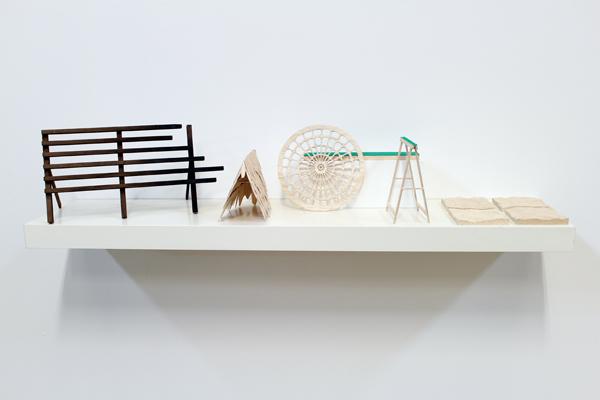
balsa, maquette wood, flock, walnut stain, shelf
From left to right: “(What a) RACK”, “COVER”, “Crystal Palace”, “PAYSAGE”,”SLAB”
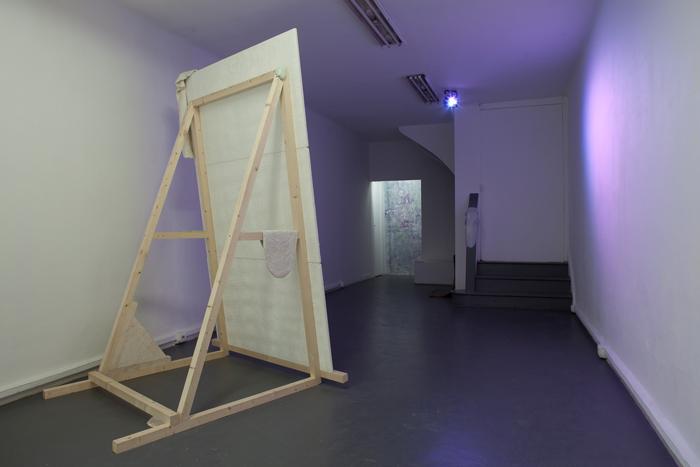
View of the exhibition Serpentine », Galerie Tator, Lyon, 2014
3-led projector, DMX controller, wood, plaster, pigments, wax, dimensions variable
Photo : © David Desaleux
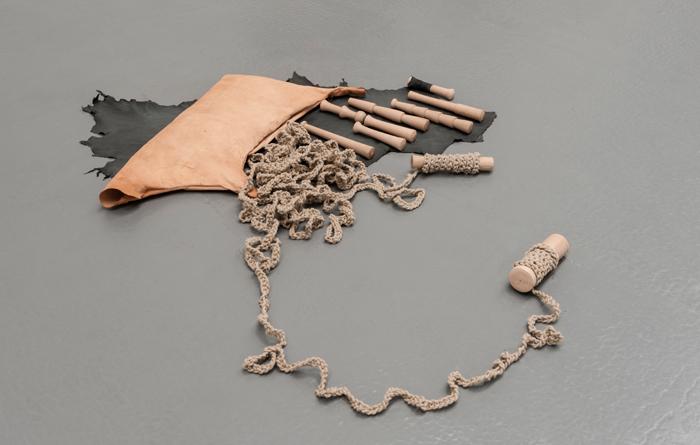
leather, beechwood, hemp rope, 140 x 150 x 20 cm
Photo : © Pierre Antoine

plaster, view of the exhibition “Serpentine”, Galerie Tator, Lyon
Photo : © David Desaleux
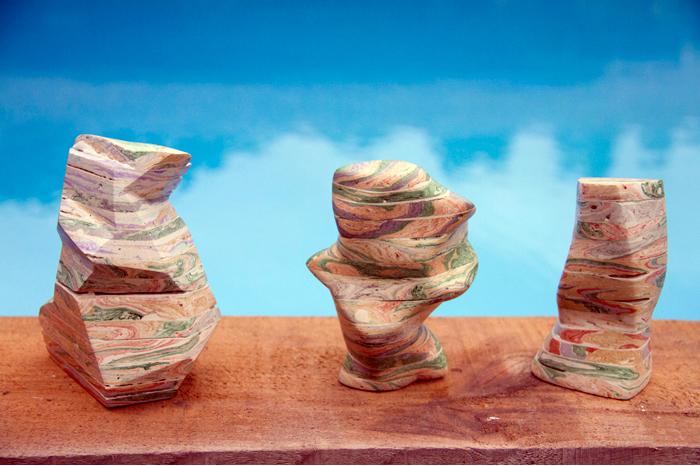
sanded plaster, dimensions variable
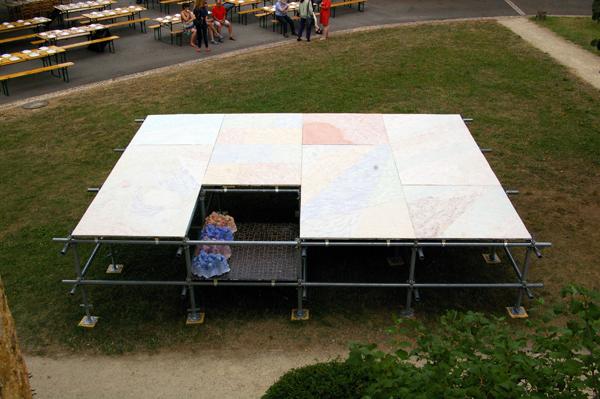
galvanized steel, plaster, pigments, 500 x 375 x 110 cm
View of the exhibition of the 25th Ateliers des Arques residency
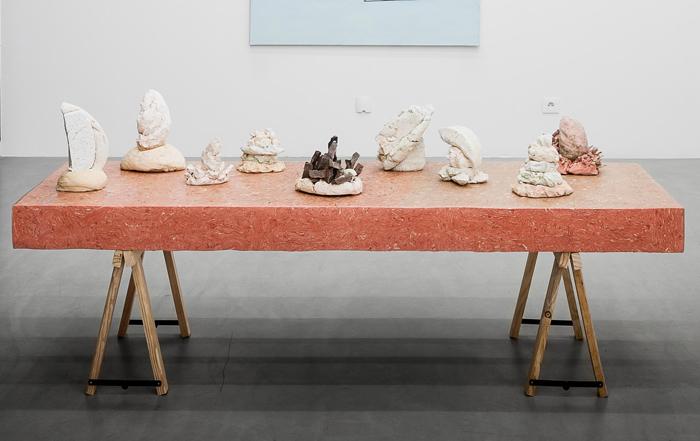
Plaster, pigments, raw clay, dimensions variable
View of the exhibition Déformation professionnelle, Galerie Paris-Beijing, 2016
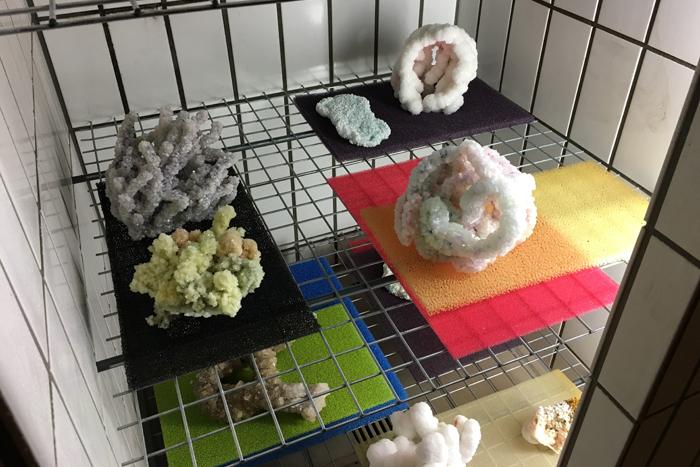
Borax crystals, lichen, pipe-cleaner, hemp rope
View of the exhibition Arrière-plan, Solarium Tournant, Pétriaux pool, old baths at Aix-les-Bains

Sculpture, acrylic resin, 165 x 165 x 11 cm ; light Installation, dmx programming
View of the window 8installation, Place du Parlement, Bordeaux,
as part of the distribution programme Crystal Palace, curated by Zebra3
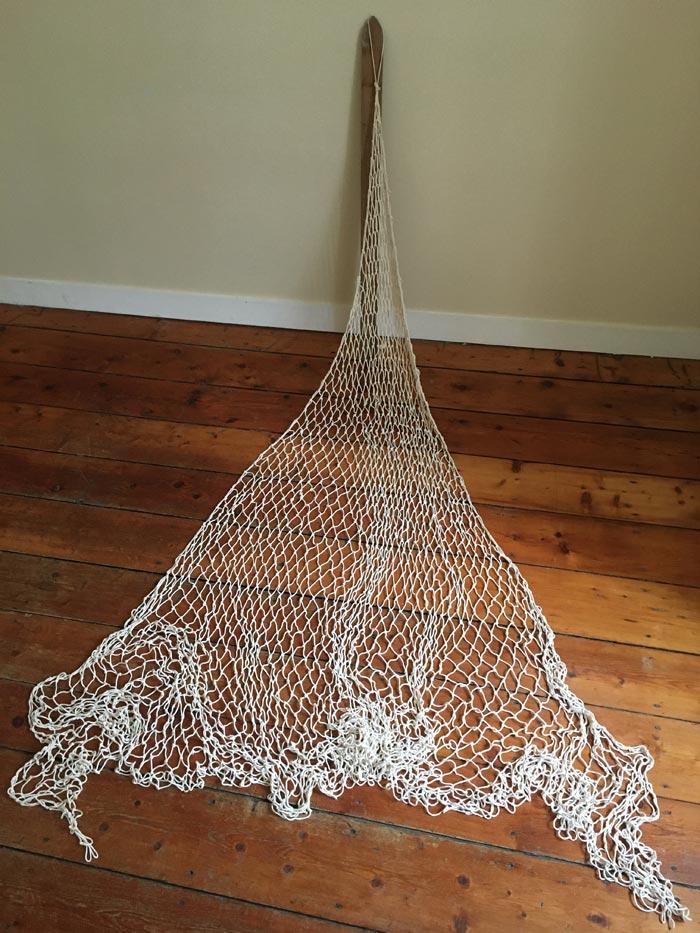

enamelled ceramic bucket, enamelled faïence tiles, ceramic pebbles,
dead coral, lichen crystallized with Borax, 140 x 80 x 40 cm
View of the exhibition Une résidence en résidence,
Les Ateliers des Arques à Meymac, Centre d'art contemporain de Meymac, 2017